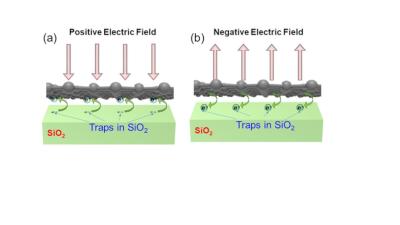The Graphene-Info weekly newsletter
Published: Tue, 12/28/21
The Graphene-Info newsletter (December 28, 2021)
Cannot read this? View it online here
GIT's graphene coating to be tested on large ships
Graphite Innovation and Technologies (GIT) uses graphene as the base for its strong, slippery and non-toxic hull paint. The coating helps prevent marine fouling – when aquatic organisms such as barnacles stick to the hull – thus improving the flow of water against the vessel, making it more efficient. Now, the coating will be heavily tested on large vessels operated by Oceanex and Baffin Fisheries.
“The vessels operated by Oceanex and Baffin Fisheries are larger vessels that move at a much higher speed than the small inshore fishing vessels previously tested under our contract with Transport Canada,” said Mo AlGermozi, President of Graphite Innovation and Technologies. “It is so much more comparable to the large transport vessels that we target as key customers, as transport fleets are more interested in reducing fuel costs and improving their environmental impact.”
Researchers examine the mechanism of electric field detection in microscale graphene sensors
Researchers at Japan Advanced Institute of Science and Technology (JAIST) and Otowa Electric, a lightning protection equipment manufacturer, have used graphene as an electric field sensor that can detect both positive and negative electric fields.

The response of the sensor is recorded as the change in drain current under the application of an electric field. In addition, by systematic analysis, The team established the mechanism of the graphene electric field sensor, which was found to be different from what they expected.
Latvia invests in project to develop graphene-enhanced ballistic protective vest
Latvia has allocated $1.4 million divided between three innovative projects that aim to improve electromagnetic protection and cybersecurity and to develop a ballistic protective vest to protect UAVs.
The project for a prototype of a ballistic protective vest will feature a pressure-sensitive layer with graphene and silicon aerogel for accurate reception of impact. This effort has been awarded funding of €449,000 ($508,000).
Researchers develop graphene-biosensors for brain machine interfaces
Researchers at the University of Technology Sydney (UTS) have developed a novel graphene-based biosensor, set to drive new innovations in brain-controlled robotics.
The biosensor adheres to the skin of the face and head in order to detect electrical signals being sent by the brain. These signals can be translated into commands to control autonomous robotic systems. The sensor, made of epitaxial graphene grown onto a silicon carbide on silicon substrate, overcomes the major challenges of corrosion, durability and skin-contact resistance.
New graphene-based neural probes improve detection of epileptic brain signals
Researchers the UK and Spain have demonstrated that tiny graphene neural probes can be used safely to improve our understanding of the causes of epilepsy.
The graphene depth neural probe (gDNP) consists of a millimeter-long linear array of micro-transistors imbedded in a micrometer-thin polymeric flexible substrate. The transistors were developed by a collaboration between The University of Manchester’s Neuromedicine Lab and UCL’s Institute of Neurology along with their Graphene Flagship partners.
Researchers stabilize the edges of graphene nanoribbons and measure their magnetic properties
Researchers at Lawrence Berkeley National Laboratory (Berkeley Lab) and UC Berkeley have developed a method to stabilize the edges of graphene nanoribbons and directly measure their unique magnetic properties.
The team, co-led by Felix Fischer and Steven Louie from Berkeley Lab’s Materials Sciences Division, found that by substituting some of the carbon atoms along the ribbon’s zigzag edges with nitrogen atoms, they could discretely tune the local electronic structure without disrupting the magnetic properties. This subtle structural change further enabled the development of a scanning probe microscopy technique for measuring the material’s local magnetism at the atomic scale.
The best of 2021 - top graphene stories
2021 will soon be over - and the graphene industry faced another year with COVID-19 implications, but also of new projects, new products on the market and exciting new graphene research.
Here are the top 10 stories posted on Graphene-Info in 2021, ranked by popularity (i.e. how many people read the story):
- Graphene oxide gives a boost to new intranasal flu vaccine (May 4)
- Graphene-based concrete used in a commercial setting for the first time (May 26)
- Graphene-enhanced G1 Wonder mask - hands on review (Jan 23)
- Researchers take a closer look at a mysterious graphene oxide phenomenon (Sep 15)
- "Flash Graphene" process modified to produce graphene from rubber waste (Mar 30)
- Graphene-enhanced concrete: recent developments (Aug 10)
- First commercial contract for GO-enhanced water filtration membranes (Aug 2)
- GMG updates on graphene aluminum-ion batteries performance (May 12)
- Companies respond to graphene masks "health hazard" scare (Apr 6)
- GAC's graphene-battery powered Aion V to enter production in September 2021 (Feb 2)
Sparc Technologies reports successfull testing of graphene-enhaned epoxy coatings
In 2020 Sparc Technologies acquired Graphene Technology Solutions (GTS) and announced plans to become a “significant developer of graphene-based products".
Sparc announced today that after six months of testing, its graphene-based additives was found to offer up to 40% improvement in the anti-corrosive performance of atmospheric epoxy coatings. The company used commercially available epoxy coatings available from leading coatings manufacturers.
GMG sends graphene aluminium-ion batteries to customers for testing
Graphene Manufacturing Group (GMG) has announced that its graphene aluminium-ion batteries ("G+AI Battery") 2032 type coin cell prototypes have been sent to a number of prospective customers around the world.
GMG reports that coin cell testing to date has demonstrated that the GMG 2032 type G+AI Battery coin cell prototypes are fully rechargeable in several seconds, retain capacity for several thousand charge and discharge cycles, are non-flammable, and are relatively non-toxic and almost fully recyclable. These characteristics compare favorably against typical rechargeable Lithium-Ion 2032 type coin cells which take 3-6 hours to recharge, are toxic and can be quite harmful if ingested, are difficult to recycle, are flammable under certain conditions, and degrade more rapidly in performance.







